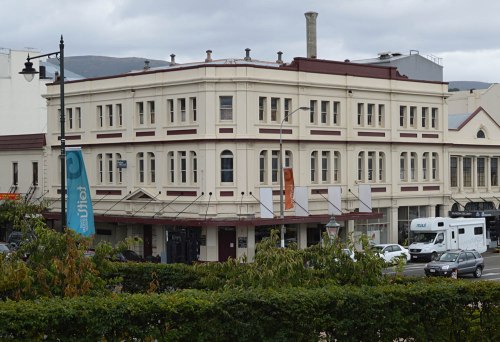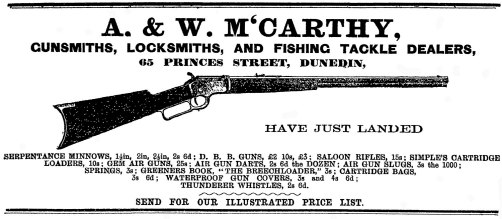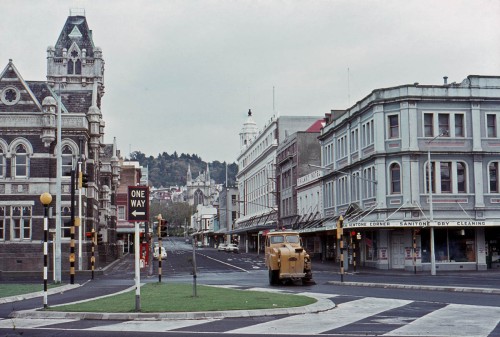Built: 1907
Address: Cr Stuart and Castle streets
Architect: Walden & Barton
Builders: G. Simpson & Co.
I’ve posted about a few Lower Stuart Street buildings now and there’s a reason why many of them are from the Edwardian period. The development of Lower Stuart Street progressed apace after the site of the new railway station was finally settled in 1902. It was obvious that a lot of foot traffic would soon be using the street, and it wasn’t long before modest wooden buildings disappeared and vacant sites were built on. Within about ten years a dozen substantial new buildings went up. This one was built for A. &. W. McCarthy Ltd, an old firm of gunsmiths, locksmiths, and fishing equipment specialists. Samuel McCarthy had set up business in Dunedin in 1861, originally as a gunsmith, locksmith, and bellhanger. Sam’s sons Arthur and Walter took over in 1890 and the firm then took on its familiar ‘A. & W.’ name.
McCarthy’s new building went up in 1907. Tenders were called in February and the building was completed before the year was out, with the firm moving from their old premises at 65 Princes Street. The architects were Walden & Barton and the building pairs nicely with the Sweeting’s fish shop on the other side of Stuart Street, which they also designed in 1907. The architecture is a composite Edwardian style that draws from various periods, sometimes loosely called ‘Queen Anne’, and transitioning towards more modern styles. The building is large and handsome and on a prominent corner, yet somehow it manages to be unassuming. It’s sympathetic in scale and design with its grandiose neighbours, the Law Courts and the Railway Station. The gentle curves to the first-floor window surrounds are a nice touch, and pilasters, cornices, and recessed panels give interest to the facades. The pediment above the stairway entrance would have been more prominent before the hanging verandah was added. The building contractors were G. Simpson & Co.
McCarthy’s remained in the building for some 90 years but in its later years the shop itself was moved to the old dairy co-operative premises next door in Castle Street. Five generations of the family ran the business. They became the leading importer of English guns and increasingly specialised in fishing equipment. They were famous for their catalogue service (which even drew in overseas customers) and for a time they had branches in Invercargill and Palmerston North. They had shops and offices in the Stuart Street building, as well as workshops for their own manufacturing department. Children were paid to collect bags of cocoon bodies, which were used to make fishing lures. McCarthy’s fishing reels are now collectors items.
The shop kept a modest appearance and Cormac McCarthy recalled: ‘There were a lot of customers over on the West Coast who used to buy the mail order catalogues. They were often terribly disappointed when they got to Dunedin for the first time. They expected a place about three times as big as Arthur Barnett, with rows and rows of guns and fishing rods, and here was this little shop with an old bloke with a beard running around.’
Perhaps unusually for a gunsmith, Arthur McCarthy was a pacifist. He studied socialism and Marxism and opposed conscription during World War I. He was a labour movement activist and became national secretary of the United Labour Party in 1912, and later became involved in the Social Credit movement. According to his grandson he had a reputation for having a fiery temper and giving firm advice. Caroline Martin recorded that ‘one of the more colourful stories about A.P. McCarthy involved prostitutes from the Railway Hotel next door who were in the habit of throwing their used unmentionables into the shared courtyard below’.
A. & W. McCarthy went into liquidation in 1999, by which time they claimed to be the oldest family-run business in Australasia. The firm’s stock and name were bought by Centrefire, which currently trades as Centrefire McCarthy’s in Moray Place. An immense accumulation of antique stock and memorabilia was sold by auction.
Many others have leased premises in McCarthy’s Buildings, which originally included six ground floor shops. The fruiterers, Steel’s, occupied the shop at 10 Stuart for 77 years from 1921 to 1988. Upstairs, an unarmed combat training school has occupied the building for the last 75 years.
Wrestling teacher and unarmed combat instructor Harry Baldock (1905-1991) moved to Dunedin in 1929 and opened a new gymnasium upstairs in the building in 1938. His school became known as the Baldock Institute. During the Second World War, Baldock was the New Zealand chief unarmed combat instructor and physical training instructor at Burnham camp as well as Forbury and Wingatui camps. He taught national wrestling champions and hosted many visiting international wrestlers. His wife, Iris, was a masseuse and physiotherapist who had worked as a nurse at convalescent hospitals for returned soldiers during the war.
In 1973 Geoff (‘Tank’) Todd began training at the Baldock Institute, initially in weight training, physical culture, wrestling, boxing, and Jiu Jitsu, and later unarmed combat. Todd took over the school in 1986 and it became Todd Group, which refocused towards unarmed combat. As of 2013, the group has an instructing team of over 100 instructors and 30 depots worldwide. It also operates a 280 acre 100-man accommodation training camp. Todd Group still runs a gymnasium at 6 Stuart Street. You can read more about their history on their website.
In 2005 the Stuart Street Potters Co-operative opened a gallery and shop at no.12. Koru Gallery arts co-operative occupies the corner shop.
The exterior of building has changed little apart from the addition of hanging verandahs in 1938. Even the original shop fronts remain; and inside, tongue-and-groove wall linings can still be seen. The building is currently owned by Allied Press.

Newspaper references:
Otago Daily Times, 8 August 1906 p.8 (removal of old buildings), 18 February 1907 p.6 (call for tenders), 11 May 1907 p.12 (description), 24 December 1993 p.13 (‘In the family for 132 years’ by Caroline Martin), 18 May 1999 p.2 (McCarthy’s in liquidation), 18 June 1999 p.4 (Centrefire purchase), 24 June 1999 p.3 (McCarthy’s auction). Accessed from Papers Past (National Library of New Zealand).
Other references:
Colbert, Roy. ‘Generation Game’ in North and South, no.126 (September 1996), p.16; McCarthy, A.C. ‘McCarthy, Arthur Peter (1862-1947)’ in Southern People: A Dictionary of Otago-Southland Biography (Dunedin: Longacre Press, 1998), pp.293-294; 80 Years of Combative Excellence [DVD]. Dunedin: Todd Group, [2007]; Stone’s Otago and Southland Directory; Wise’s New Zealand Post Office Directory; telephone directories; Dunedin City Council permit records and deposited plans.





Imagine planning a career as a bell hanger.
Yeah! I wonder how many there were in Dunedin.
I worked at the shop in the 70s and moved to Invercargill to manage the branch.